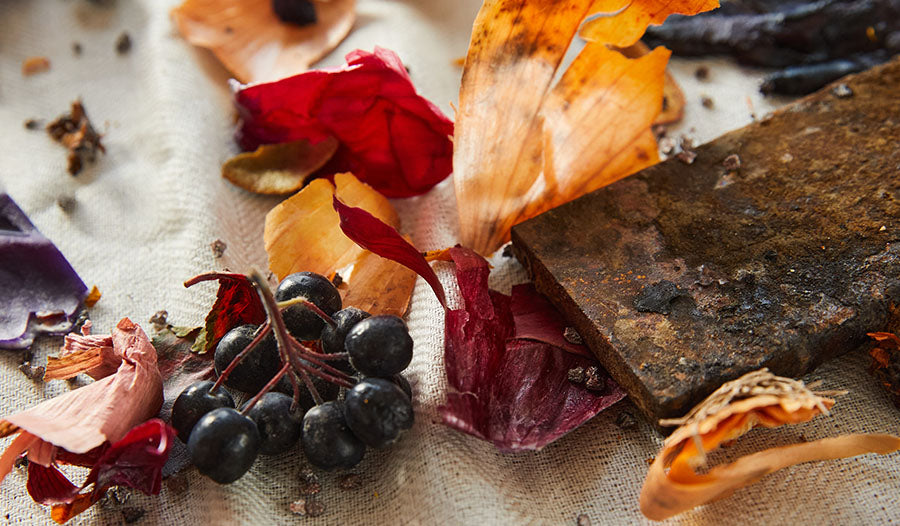
DYES WITH A STORY TO TELL

There was a time when colour was worth crossing the Sahara for. It drove men to risk life or scurvy to bring back logwood bark from across the Atlantic, or swim under the surface of the sea to harvest unearthly colours. Far-flung villages became famous for the luck of having a plant or beetle that could produce a dye like no other. Travel the world over, and the colour souvenirs were truly things of wonder: a black of a somberness never before seen in Europe, or a purple so deep it was too rich for even the Empress of Rome.
The first natural dyes were suspiciously akin to food stains: yellow turmeric, orange saffron, red annatto and rosy-pink safflower. It’s easy to imagine the accidental discoveries – turmeric dribbled down the front of your drab beige tunic didn’t wash out, but brown beef stew did. More than just stains, the colours of these ground plants formed a chemical bond with the fibres of the cloth.
Never content with what chance gives us, humanity, across cultures and over millennia, tried to find ever more substances that could dye cloth, and do it better. Besides colour, “fastness” – the ability of a dye to maintain its colour without fading or washing away – was key. The discovery and perfection of the use of mordants – binding agents that improved the fastness of a dye, and in some cases influencing the very colour produced – became a science in itself. Recipes and techniques for the best dyes spread with the fame of the cloth.

Along the cross-continental trade routes, people went mad for the rich, bright blue of true indigo, a flowering plant harvested and processed in India, Vietnam and parts of sub-Saharan Africa. The people of Tyre, in modern-day Lebanon, somehow discovered that the mucous secretion from the hypobranchial gland of a predatory Mediterranean sea snail made an excellent purple. There are two ways to extract the luxury mucus: by gently milking the snail (and letting it live another day for another milking), or by crushing the snails and draining out the liquid. Twelve thousand snails yielded 1.4 grams of pure dye – enough for one garment.
When crushed, gray cochineal beetles from Central America turned orange with a base mordant, purple with an acid and burgundy with neutral water. But the dye discovery that truly transformed clothing – at least in the eyes of this writer, the Spanish clergy and generations of men and women of certain dispositions – is the fast black of the flowering logwood tree of Belize.

With a field guide to plants and basic pointers, you can identify a number of pigment sources then experiment with clothing. Keep in mind that natural dyes only work with natural fibres. Wool is the easiest to dye, while cotton and silk require a few extra steps. Spring blossoms, tree bark and nuts are all natural dye stuffs that work well, and a good dye recipe book will tell you when to pick these and how to extract their pigment. If you’re city-bound, pick marigolds, zinnias or dahlias. These flowers give the best colours when freshly picked – drying the petals first mutes and weakens the pigment. Foods such as blueberries, mulberries and elderberries can be used fresh or frozen, and fresh beetroot, carrot tops and spinach leaves should also produce nice colours.
Extract from the article A Splendid Shade of Milked Snail: Nature’s Hidden Rainbow, written by Aurora Almendral in Issue 57 Meteorological. Find out how to read the rest of the article here:
--
Free silk scarf for new subscribers

For Black Friday, we have a great treat in store for those taking out a new print subscription of 1 year or more. The first fifty new print subscribers will receive a complimentary scarf from Spirit of Threads. The silk is naturally dyed by rolling and tying plants, vegetables, and minerals into the fabric, which is then steamed. The result is a unique shawl speckled with the coloured pigments left by the petals.
This Black Friday offer will be taking place from 26 -29 November. While stocks last.

